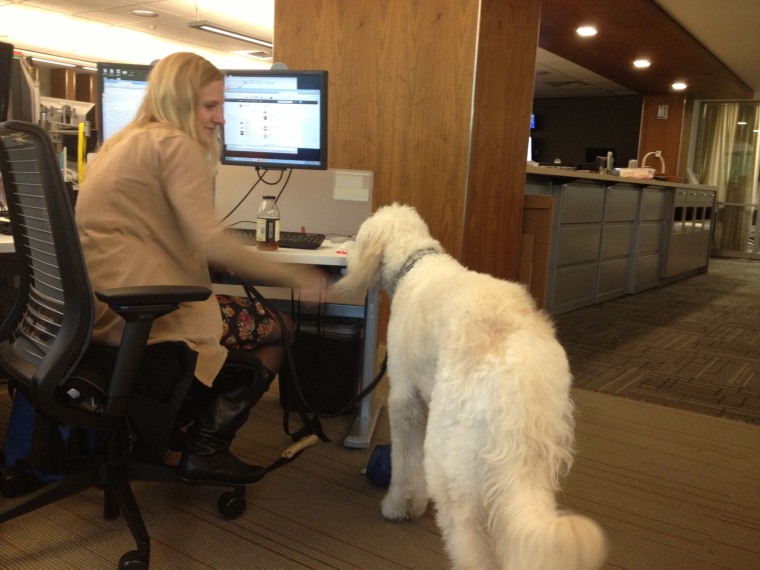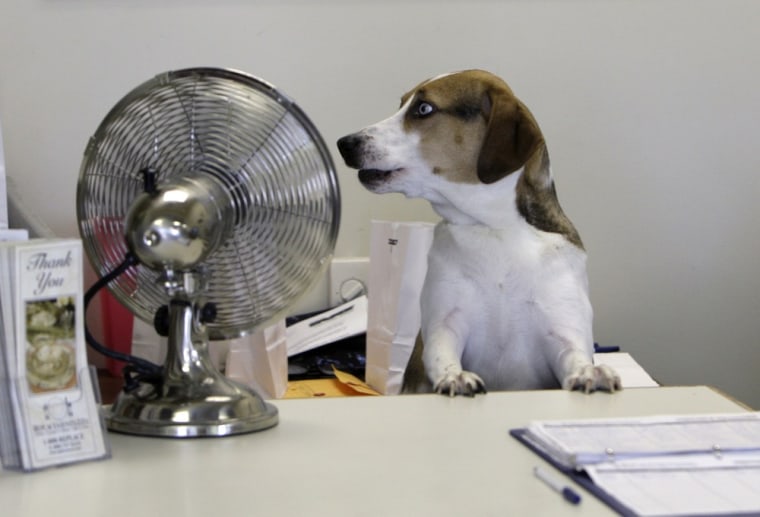You may find some new friends at the office today – four-legged ones.
It’s the 15th annual Take Your Dog to Work Day. The unofficial holiday, which is always held on the first Friday after Father’s Day, was started by Pet Sitters International as a way to give back to the pet community and encourage pet adoption.
The percentage of people who take their pets to work – yes, some bring their cats – is still small, but growing.
“It continues to go up because it’s beneficial to people,” said Bob Vetere, president and CEO of the American Pet Products Association (APPA) who works in a pet-friendly office. “You can see the difference in people as they respond to these animals.”
About 3 percent of dog owners (1.4 million people) said they had taken their pet to work with them in the last 12 months, according to an APPA survey conducted in 2010. That was up from just 1 percent six years earlier.

Greta Springett, a project manager at Delphic Digital in Philadelphia, feels lucky to work for a company that lets her bring her dog Phoebe, a Cavalier King Charles Spaniel, to the office whenever she wants. “It gives me peace of mind,” she said. “When Phoebe’s here with me, I know she’s well taken care of and she has a calming effect on everyone. It’s really a nice perk.”
Delphic Digital, a digital advertising agency with 25 employees, has always allowed – even encouraged – employees to bring their dogs to the office.
“They bring smiles to employee’s faces,” said co-owner Lance Hollander. “It makes the work environment easier for people trying to handle a busy life.”
Hollander says they had one potty accident, but other than that there haven’t been any problems.
Do pets make a difference in the workplace?
Pet lovers always say how beneficial it is to bring their dogs to work and researchers at Virginia Commonwealth University believe they may be right.
They are exploring the people-pet connection in the workplace. A study published last year found that bringing a pet to work is beneficial to the employee and the employer.
“Our study seems to support the idea that a dog presence in the workplace may reduce stress, increase job satisfaction and communication and really help with the issue of job burnout,” said Prof. Randolph Barker, the principal investigator for this study.
While still preliminary, he called the findings significant and exciting.
He also told NBC News that pets in the office increase communication, helps with team-building and creates more loyal employees.
“If you’re in an environment where you feel you are supported and perceived as being valuable, your sense of belonging increases and you tend to want to give more back to that organization,” he said.
About half the people who brought their dog to work told researchers it increased their productivity.
And distraction did not seem to be an issue. About 80 percent of those who did not own a pet or did not bring their pooch to work said the dogs in the office were not a distraction and had no negative effect on their productivity.
Submit your pet photos here
Let’s not forget: Some people don’t like furry office mates. Slate.com columnist Farhad Manjoo, who admits he’s not a dog person, told NBC News he finds them annoying and distracting.
“I just don’t think it’s appropriate,” he said. “A lot of people have allergies or are scared of dogs. I also think sometimes dog owners aren't as mindful as they need to be to keep their dogs on a leash or knowing the friendliness of their dog to strangers.”
Manjoo likes employers who are flexible and non-authoritarian, but he feels “one person’s happiness is another person’s anxiety.” In a recent column, “No, I Do Not Want to Pet Your Dog,” Manjoo spelled out why he thinks it’s time to “take America back” from the dogs. His biggest peeve: "There’s now a cultural assumption that everyone must love dogs."
There must be rules
Experts say employers who allow pets need to have a policy that spells out the rules. This would include medical requirements – such as current on vaccinations – and behavioral characteristics, such as well-socialized, potty trained and no aggression.

Be thoughtful and respectful of any concernes your co-workers might have and take action when needed,” advised Dr. Kerri Marshall, chief veterinary officer with Trupanion pet insurance.
You need to realize that your beloved pet may behave differently around new people and new pets.
“If that’s the case, maybe your pet shouldn’t be coming in or it needs some behavior classes. You don’t want co-workers to feel uncomfortable,” she said.
At Trupanion, an office filled with pets, they use the Pet Buddy system. When an employee decides to bring their pet to work, they’re teamed up with someone who already does that. The buddy will introduce the new pet to other people and pets in the office and provide guidance to make sure everything goes smoothly.
The buddy watches for problems, records interactions and decides if the dog or cat will be allowed to come to work. That usually happens in a day or two.
Here are some guidelines from Pet Sitters International:
- Dogs should be kept on leashes, unless in the employee’s office or cubicle. Even the best-behaved dogs may not understand that not everyone loves puppy kisses or pouncing pooches. Respect co-workers’ space. Co-workers who want to pet your dog will likely come to you.
- Employees should use baby gates to prevent dogs from leaving their offices or cubicles unsupervised. In the middle of an important sales call or during a visit from a business partner is not the best time for Fido to dash out of your office.
- Specific areas, such as bathrooms or employee dining halls, should be designated as dog-free. Even on TYDTWDay, there will be limitations to where your dog can roam. Work with management and co-workers to decide which areas will be dog-free.
- Have a back-up plan for taking the dog home if he is not comfortable in the work environment. While most dogs love spending a day at the office, it may be that your dog is not ready to enter the workforce. Have a back-up plan, such as a spouse, friend or professional pet sitter who can take care of your pet if he needs to leave the office.
Herb Weisbaum is The ConsumerMan. Follow him on Facebook and Twitter or visit The ConsumerMan website. He has a dog, Sam, and a cat, Casey.
